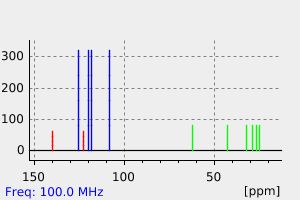6-(9'H-carbazol-9'-yl)hexan-1-ol | 128941-12-8
中文名称
——
中文别名
——
英文名称
6-(9'H-carbazol-9'-yl)hexan-1-ol
英文别名
6-(9H-carbazol-9-yl)hexan-1-ol;6-(9H-carbazol-9-yl)hexanol;9-(6-hydroxyhexyl)carbazole;N-(6-hydroxyhexyl)carbazole;9H-carbazole-9-hexanol;6-carbazol-9-ylhexan-1-ol
CAS
128941-12-8
化学式
C18H21NO
mdl
——
分子量
267.371
InChiKey
KCFHXVCGEQRWDQ-UHFFFAOYSA-N
BEILSTEIN
——
EINECS
——
-
物化性质
-
计算性质
-
ADMET
-
安全信息
-
SDS
-
制备方法与用途
-
上下游信息
-
文献信息
-
表征谱图
-
同类化合物
-
相关功能分类
-
相关结构分类
物化性质
-
沸点:455.6±37.0 °C(Predicted)
-
密度:1.09±0.1 g/cm3(Predicted)
计算性质
-
辛醇/水分配系数(LogP):4
-
重原子数:20
-
可旋转键数:6
-
环数:3.0
-
sp3杂化的碳原子比例:0.33
-
拓扑面积:25.2
-
氢给体数:1
-
氢受体数:1
SDS
上下游信息
-
上游原料
中文名称 英文名称 CAS号 化学式 分子量 —— 9-(hex-5-en-1-yl)-9H-carbazole 7395-03-1 C18H19N 249.356 -
下游产品
中文名称 英文名称 CAS号 化学式 分子量 —— (9H-carbazol-9-yl)hexyl acetate 249905-69-9 C20H23NO2 309.408 —— 6-(9H-Carbazol-9-yl)hexyl prop-2-enoate 117846-47-6 C21H23NO2 321.4 —— 6-(9-carbazolyl)hexyl methacrylate 128629-00-5 C22H25NO2 335.446 —— N-(6'-chlorohexyl)carbazole-3-carboxaldehyde 845640-43-9 C19H20ClNO 313.827
反应信息
-
作为反应物:描述:参考文献:名称:光诱导电子转移(PET)介导的吡啶啉衍生的氧化还原探针的断裂摘要:通过使用密度泛函理论(DFT)和时间依赖DFT(TD-DFT)计算,通过实验分析了共价连接的苯基乙酸N-烷基吡啶甲酸哌唑二唑的光解作用。与早期的观察结果发现高效的和双光子碎裂条件15℃(δ û = 0.16 GM在730纳米)为一类新的“笼”的化合物的设计开辟了道路。DOI:10.1002/chem.201801684
-
作为产物:描述:(E)-1-bromo-2-hexene 在 α,α,α-三联吡啶 、 双氧水 、 caesium carbonate 、 cobalt(II) aceylacetonate 、 sodium hydroxide 作用下, 以 四氢呋喃 、 正辛烷 、 N,N-二甲基甲酰胺 为溶剂, 反应 15.58h, 生成 6-(9'H-carbazol-9'-yl)hexan-1-ol参考文献:名称:链烯基胺的钴催化远程硼氢化反应摘要:我们在这里提出了一种普遍适用的钴催化的烯基胺远程硼氢化反应,为制备硼胺和氨基醇提供了一种实用的策略。该方法显示出广泛的底物范围和良好的官能团耐受性,可耐受一系列烯基胺,包括烷基-烷基胺、烷基-芳基胺、芳基-芳基胺和酰胺。值得注意的是,该协议还与各种天然产品和药物衍生物兼容。初步的机理研究表明,这种转变涉及迭代链行走和硼氢化序列。DOI:10.1021/acs.orglett.1c02826
-
作为试剂:描述:、 9-硼双环[3.3.1]壬烷 、 9-(hex-5-en-1-yl)-9H-carbazole 、 sodium hydroxide 、 双氧水 在 6-(9'H-carbazol-9'-yl)hexan-1-ol 、 乙醚 、 crude product 、 acetone hexane 作用下, 以 四氢呋喃 、 水 、 乙醇 为溶剂, 反应 4.0h, 以The pure N-(6-hydroxyhexyl)-carbazole obtained in 61% yield的产率得到6-(9'H-carbazol-9'-yl)hexan-1-ol参考文献:名称:Methacrylate (co)polymers containing carbazolyl side groups and摘要:含有卡巴唑侧基的甲基丙烯酸酯(共)聚合物包含或由一般式(I)的重复单元组成##STR1##其中m是3到11的整数。新型含有卡巴唑侧基的甲基丙烯酸酯(共)聚合物可以优点地用作光导层中的光导体,特别是电子摄影记录元件的光导体。公开号:US05176962A1
文献信息
-
Calix[4]resorcinarene-based branched macromolecules for all-optical photorefractive applications作者:Wei Liu、Haitao Yang、Wenbo Wu、Hongyan Gao、Shidang Xu、Qing Guo、Yingliang Liu、Shengang Xu、Shaokui CaoDOI:10.1039/c6tc04062d日期:——By introducing nonlinear optical (NLO) chromophores to calix[4]resorcinarene, a non-centrosymmetric core, through powerful click chemistry reactions, two branched macromolecules (CRA-CzAZO and CRA-CzCSN) were obtained in satisfactory yields for photorefractive (PR) applications. In comparison with traditional PR materials, which usually need a high external electric field or a poling procedure to realize通过强大的点击化学反应,将非线性光学(NLO)生色团引入非中心对称核杯[4]间苯二甲烯,通过令人满意的收率获得了两个支化大分子(CRA-CzAZO和CRA-CzCSN),用于光折变(PR)应用。与通常需要高外部电场或极化过程才能实现PR效果的传统PR材料相比,CRA-CzAZO和CRA-CzCSN可以表现出良好的全光学PR(AOPR)效果,即显示PR效果由于其特殊的非中心对称拓扑结构,因此没有外部电场。采用两束耦合技术来证明PR性能,并具有83.2 cm的高耦合增益系数通过掺有30% N-乙基咔唑作为增塑剂和光电导体,以及1%C 60作为光敏剂的CRA-CzAZO光学透明薄膜,在零场下实现-1,这表明基于CRA-CzAZO的复合薄膜可以可以作为实际PR应用程序的良好候选者。更重要的是, CRA-CzAZO和CRA-CzCSN为AOPR材料提供了一种新的简单设计策略。
-
Synthesis and Structural Effect of Multifunctional Photorefractive Polymers Containing Monolithic Chromophores作者:Jaehoon Hwang、Jiwon Sohn、Soo Young ParkDOI:10.1021/ma034104g日期:2003.10.1acrylate to give photorefractive polymers with Tg near room temperature. The structural effects of these monolithic photorefractive chromophores were investigated in terms of the optical nonlinearity, photoconductivity, and photorefractivity of the acrylate copolymers. The opposite direction of asymmetric energy transfer in two-beam coupling measurement indicated that the photorefractive polymers had the different
-
Fluorescent Gelators for Detection of Explosives作者:Kenji Hanabusa、Shingo Takata、Masafumi Fujisaki、Yasushi Nomura、Masahiro SuzukiDOI:10.1246/bcsj.20160232日期:2016.11.15Carbazole-, quinoline-, benzothiazole-, and stilbene-containing fluorescent gelators are synthesized by connecting gelation-driving segments, and their gelation abilities are studied with 13 solvents. Fibrous thin-layer films are prepared on quartz plates from the solutions or gels, and they are studied as chemosensors for explosives. Fluorescence quenching of the films upon exposure to saturated TNT or RDX vapor is used to evaluate the abilities of the films to detect explosives. The relationship between the thickness of the thin-layer film and the quenching efficiency upon exposure to TNT is studied. The morphologies of the thin-layer films are observed by dynamic force mode scanning probe microscopy and discussed with regard to their fluorescence quenching. The interactions among chromophores in the gels, thin-layer films, and solutions are studied by variable-temperature spectroscopy. The mechanism of TNT detection is discussed from the viewpoint of the HOMO and LUMO energy levels.
-
Iron-Catalyzed Photoinduced Remote C(sp<sup>3</sup>)–H Amination of Free Alcohols作者:Ni Xiong、Yang Li、Rong ZengDOI:10.1021/acs.orglett.1c03488日期:2021.11.19We report a general photocatalytic protocol for the remote C(sp3)–H bond amination of free aliphatic alcohols. The electron transfer between the abundant and inexpensive catalyst FeCl3 and simple alkanols under blue LED irradiation enables the alkoxy radical formation under mild redox-neutral conditions, with no need for additional oxidant and prefunctionalization. The subsequent selective 1,5-hydrogen我们报告了游离脂肪醇远程 C(sp 3 )-H 键胺化的通用光催化协议。在蓝光 LED 照射下,丰富且廉价的催化剂 FeCl 3和简单链烷醇之间的电子转移使得在温和的氧化还原中性条件下形成烷氧基自由基,无需额外的氧化剂和预官能化。随后的选择性 1,5- 氢原子转移 (HAT) 和胺化提供了一种简单有效的方法,可以从现成的大量醇中获取分子复杂性。
-
A small-molecule-based device for data storage and electro-optical switch applications作者:Hua Li、Zhengneng Jin、Najun Li、Qingfeng Xu、Hongwei Gu、Jianmei Lu、Xuewei Xia、Lihua WangDOI:10.1039/c1jm00065a日期:——A sandwich device fabricated with light sensitive organic molecules shows excellent dynamic random access memory and excellent electro-optical switch behavior with high ON/OFF current ratio (109) and long-term stability under continuous stress. We envision this type of organic molecules will be an important alternative to the traditional materials for electronic applications.用光敏感有机分子制造的夹层器件显示出极佳的动态随机存取存储器和优异的电光开关性能,具有高导通/关断电流比(109)和在持续应力下的长期稳定性。我们预计这类有机分子将成为传统电子应用材料的重要替代品。
表征谱图
-
氢谱1HNMR
-
质谱MS
-
碳谱13CNMR
-
红外IR
-
拉曼Raman
-
峰位数据
-
峰位匹配
-
表征信息
同类化合物
(Z)-3-[[[2,4-二甲基-3-(乙氧羰基)吡咯-5-基]亚甲基]吲哚-2--2-
(S)-(-)-5'-苄氧基苯基卡维地洛
(R)-(+)-5'-苄氧基卡维地洛
(R)-卡洛芬
(N-(Boc)-2-吲哚基)二甲基硅烷醇钠
(E)-2-氰基-3-(5-(2-辛基-7-(4-(对甲苯基)-1,2,3,3a,4,8b-六氢环戊[b]吲哚-7-基)-2H-苯并[d][1,2,3]三唑-4-基)噻吩-2-基)丙烯酸
(4aS,9bR)-6-溴-2,3,4,4a,5,9b-六氢-1H-吡啶并[4,3-B]吲哚
(3Z)-3-(1H-咪唑-5-基亚甲基)-5-甲氧基-1H-吲哚-2-酮
(3Z)-3-[[[4-(二甲基氨基)苯基]亚甲基]-1H-吲哚-2-酮
(3R)-(-)-3-(1-甲基吲哚-3-基)丁酸甲酯
(3-氯-4,5-二氢-1,2-恶唑-5-基)(1,3-二氧代-1,3-二氢-2H-异吲哚-2-基)乙酸
齐多美辛
鸭脚树叶碱
鸭脚木碱,鸡骨常山碱
鲜麦得新糖
高氯酸1,1’-二(十六烷基)-3,3,3’,3’-四甲基吲哚碳菁
马鲁司特
马鞭草(VERBENAOFFICINALIS)提取物
马来酸阿洛司琼
马来酸替加色罗
顺式-ent-他达拉非
顺式-1,3,4,4a,5,9b-六氢-2H-吡啶并[4,3-b]吲哚-2-甲酸乙酯
顺式-(+-)-3,4-二氢-8-氯-4'-甲基-4-(甲基氨基)-螺(苯并(cd)吲哚-5(1H),2'(5'H)-呋喃)-5'-酮
靛青二磺酸二钾盐
靛藍四磺酸
靛红联二甲酚
靛红磺酸钠
靛红磺酸
靛红乙烯硫代缩酮
靛红-7-甲酸甲酯
靛红-5-磺酸钠
靛红-5-磺酸
靛红-5-硫酸钠盐二水
靛红-5-甲酸甲酯
靛红
靛玉红衍生物E804
靛玉红3'-单肟5-磺酸
靛玉红-3'-单肟
靛玉红
靛噻
青色素3联己酸染料,钾盐
雷马曲班
雷莫司琼杂质13
雷莫司琼杂质12
雷莫司琼杂质
雷替尼卜定
雄甾-1,4-二烯-3,17-二酮
阿霉素的代谢产物盐酸盐
阿贝卡尔
阿西美辛杂质3







